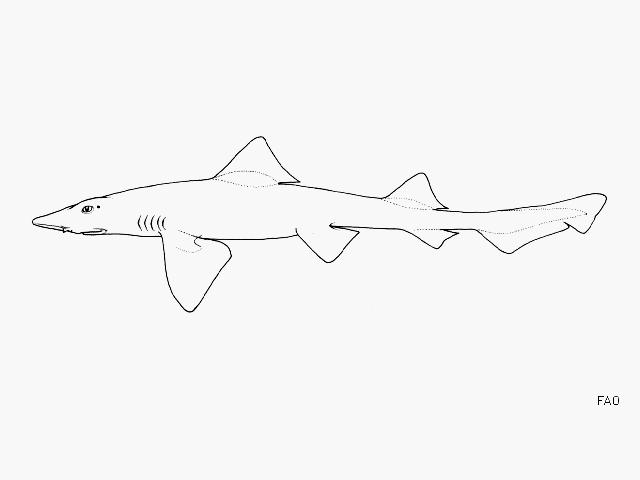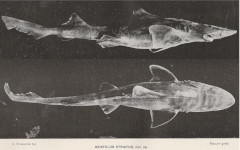Mustelus fasciatus
(Garman, 1913)
Striped smooth-hound
Classification: Elasmobranchii Carcharhiniformes Triakidae
Reference of the original description
The Plagiostomia (Sharks, Skates and Rays). Memoirs of the Museum of Comparative Zoology at Harvard College, 36, 1–528
The Plagiostomia (Sharks, Skates and Rays). Memoirs of the Museum of Comparative Zoology at Harvard College, 36, 1–528
Image of the original description
No image in first description.
No image in first description.
Synonyms / new combinations and misspellings
Galeorhinus fasciatus, Mustelus striatus
Galeorhinus fasciatus, Mustelus striatus
Description :
Citation: Mustelus fasciatus (Garman, 1913): In: Database of modern sharks, rays and chimaeras, www.shark-references.com, World Wide Web electronic publication, Version 12/2025
Please send your images of "Mustelus fasciatus" to info@shark-references.com

Mustelus fasciatus (Garman, 1913), © FAO, www.fish-base.org

Mustelus fasciatus (Garman, 1913), © FAO, www.fish-base.org
Common names
 Cazón,
Cazón,  Gatuzo,
Gatuzo,  Musola,
Musola,  Mustola listada,
Mustola listada,  Emissole rayée,
Emissole rayée,  Striped smooth hound,
Striped smooth hound,  Striped smooth-hound,
Striped smooth-hound,  Canejo malhado,
Canejo malhado,  Cação-estriado,
Cação-estriado,  Cação-malhado,
Cação-malhado,  Sebastião
Sebastião
 Cazón,
Cazón,  Gatuzo,
Gatuzo,  Musola,
Musola,  Mustola listada,
Mustola listada,  Emissole rayée,
Emissole rayée,  Striped smooth hound,
Striped smooth hound,  Striped smooth-hound,
Striped smooth-hound,  Canejo malhado,
Canejo malhado,  Cação-estriado,
Cação-estriado,  Cação-malhado,
Cação-malhado,  Sebastião
Sebastião
Short Description
Diagnosis after Compagno, 1984 [517]: Body fairly stout. Head very long, prepectoral length 22 to 24.5% of total length; snout very long and angular in lateral view, preoral snout 8 to 9% of total length, preorbital snout 9.4 to 10.2% of total length; internarial space broad, 2.9 to 3.4% of total length; eyes small, eye length 3.8 to 4.3 times (largest juveniles at about 62 cm have it over 4) in preorbital snout and 1.9 to 2.5% of total length; interorbital space broad, 4.8 to 5.2% of total length; mouth long, greater than eye length and 3.4 to 4.2% of total length; upper labial furrows considerably longer than lowers, upper furrows 2 to 2.4% of total length; teeth molariform and symmetrical, with cusp and cusplets absent and crown broadly rounded; buccopharyngeal denticles covering most of palate and floor of mouth except medial rear third. Interdorsal space 16 to 19% of total length; trailing edges of dorsal fins denticulate, without bare ceratotrichia; first dorsal broadly triangular, with posteroventrally sloping posterior margin, midbase closer to pelvic bases than pectorals; pectoral fins moderate-sized, length of anterior margins 13 to 15% of total length, width of posterior margins 11 to 13% of total length; pelvic fins large, anterior margin length 7.4 to 9.2% of total length; anal height 2.8 to 3.2% of total length; anal-caudal space shorter than second dorsal height, 4.2 to 5.6% of total length; ventral caudal lobe hardly developed in large juveniles. Crowns of lateral trunk denticles lanceolate, without longitudinal ridges or when present extending up to only half of their length. Skeleton not hypercalcified in large juveniles; palatoquadrates not subdivided; monospondylous precaudal centra 32 to 35, diplospondylous precaudal centra 23 to 30, precaudal centra 58 to 63. Colour grey or grey-brown, above, light below, no white or dark spots but with dark vertical bars on at least young and juveniles. Development unknown. Size large, adults above 62 cm.
Diagnosis after Compagno, 1984 [517]: Body fairly stout. Head very long, prepectoral length 22 to 24.5% of total length; snout very long and angular in lateral view, preoral snout 8 to 9% of total length, preorbital snout 9.4 to 10.2% of total length; internarial space broad, 2.9 to 3.4% of total length; eyes small, eye length 3.8 to 4.3 times (largest juveniles at about 62 cm have it over 4) in preorbital snout and 1.9 to 2.5% of total length; interorbital space broad, 4.8 to 5.2% of total length; mouth long, greater than eye length and 3.4 to 4.2% of total length; upper labial furrows considerably longer than lowers, upper furrows 2 to 2.4% of total length; teeth molariform and symmetrical, with cusp and cusplets absent and crown broadly rounded; buccopharyngeal denticles covering most of palate and floor of mouth except medial rear third. Interdorsal space 16 to 19% of total length; trailing edges of dorsal fins denticulate, without bare ceratotrichia; first dorsal broadly triangular, with posteroventrally sloping posterior margin, midbase closer to pelvic bases than pectorals; pectoral fins moderate-sized, length of anterior margins 13 to 15% of total length, width of posterior margins 11 to 13% of total length; pelvic fins large, anterior margin length 7.4 to 9.2% of total length; anal height 2.8 to 3.2% of total length; anal-caudal space shorter than second dorsal height, 4.2 to 5.6% of total length; ventral caudal lobe hardly developed in large juveniles. Crowns of lateral trunk denticles lanceolate, without longitudinal ridges or when present extending up to only half of their length. Skeleton not hypercalcified in large juveniles; palatoquadrates not subdivided; monospondylous precaudal centra 32 to 35, diplospondylous precaudal centra 23 to 30, precaudal centra 58 to 63. Colour grey or grey-brown, above, light below, no white or dark spots but with dark vertical bars on at least young and juveniles. Development unknown. Size large, adults above 62 cm.
Human uses
fisheries: commercial
fisheries: commercial
Biology
Ovoviviparous, embryos feed solely on yolk [733]. Distinct pairing with embrace [17086]. Migrate to the shore to give birth at the shortest time possible (Ref. 56500). Found on the continental shelf. Newbies are found on beaches of between 1 and 5 m depth, juveniles occupy inshore waters at between 15 and 50 m, and adults are found down to 50 and on upper slopes of up to 250 m in depth (Ref. 56500). Presumably feeds on crustaceans and other benthic invertebrates.
Ovoviviparous, embryos feed solely on yolk [733]. Distinct pairing with embrace [17086]. Migrate to the shore to give birth at the shortest time possible (Ref. 56500). Found on the continental shelf. Newbies are found on beaches of between 1 and 5 m depth, juveniles occupy inshore waters at between 15 and 50 m, and adults are found down to 50 and on upper slopes of up to 250 m in depth (Ref. 56500). Presumably feeds on crustaceans and other benthic invertebrates.
Remarks
shark-references Species-ID=3792;
shark-references Species-ID=3792;
Parasites (arranged by Jürgen Pollerspöck)
Cestoda
Cestoda

















